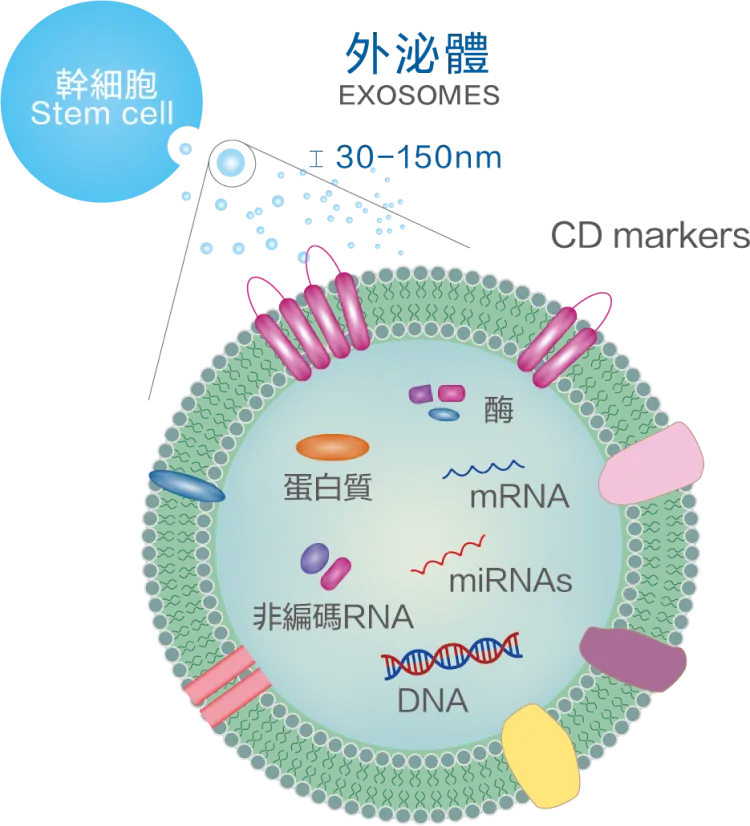

幹細胞與外泌體
腦神經細胞死亡後難以再生,復健能增加新的神經連結,但速度緩慢
找尋可以提供腦組織再生新細胞之方法搭配復健,增加希望!
您因家人或自己的神經退化疾病感到擔憂、無力嗎?
不必再一個人抱頭煩惱了!
讓史坦賽薾團隊陪您搶先認識全球醫療新趨勢,幫助您應對挑戰,獲得專業支持。
常見困擾
復健幫助我的病情穩定,但我還想知道其他可以再更進步的方法
流失生活主導權的中風族群
腦血管堵塞,血液、氧氣無法送達腦部,造成腦神經死亡,最後演變成腦部功能受損,影響病患的日常生活能力。
吃了藥噁心還頭暈,好難受~
病症惡化,可換藥可能有適應期
神經退化的帕金森病友
神經細胞受損死亡,導致多巴胺神經退化,引發動作障礙
記不得近期做過的事 ,害怕連熟悉的家人、事物也認不得
失去珍貴記憶的阿茲海默症病友
腦神經退化,造成記憶力、認知能力衰退
什麼是幹細胞?
幹細胞是一種特殊的細胞,是體內每個細胞、組織和器官的基礎細胞,就像一個微型空白晶片,最終可以經由程式設計來達成特定的任務。幹細胞具有兩個重要特性,其一為再生(self-renew),幹細胞可以分裂並產生更多的幹細胞;其二為分化潛能(multipotential differentiation) ,可轉變為其他執行不同功能的細胞。這兩種特性對於組織的維持及受傷後的修復都極為重要。依照分化能力可分為:
1. 全能幹細胞(Totipotent),如受精卵
2. 萬能幹細胞(Pluripotent),如胚胎幹細胞(ESC)和人工誘導多能幹細胞(iPSC)
3. 多能幹細胞(Multipotent),如造血幹細胞(HSC)和間質幹細胞(MSC)
4. 單能幹細胞(Unipotent)
再生及分化
再生與分化為幹細胞最重要的兩種特性。再生,也叫做自我更新,是幹細胞生殖產生一個或兩個子代幹細胞的過程,子代幹細胞具有相同的自我更新和分化能力。憑藉這種能力,幹細胞能經歷多次細胞分裂生殖的週期。分化則是幹細胞可分化為骨骼、軟骨、肌肉、神經等多種細胞;幹細胞的再生及分化特性,對於組織受損的修復及機能重建有極大的幫助。
歸巢
幹細胞具有歸巢的特性,歸巢即是讓「幹細胞找到目的地」的能力。此現象是由受損的器官組織分泌生物激素引導完成。與使用藥物治療不同,幹細胞到達目的地發揮效果後並不會被代謝,而是藉由再生及分化的能力修復或是取代受損組織的細胞。
分泌因子
幹細胞分泌因子是細胞與細胞之間溝通的訊息橋梁,用來刺激與活化細胞的角色;我們細胞的細胞膜上有很多接收器,就像是多種類的鎖頭,當細胞面臨受傷或是老化等狀況,需要分化製造出其子代細胞的時候,就需要由這些幹細胞分泌因子,也就是鑰匙的角色,來開啟細胞膜上的鎖頭,啟動細胞的複製分化和更新的反應,進而使新生的細胞數量增加,協同身體細胞的修護與再生。幹細胞分泌因子是多種生物活性因子的集合,它們協同作用以產生治療效果;其中的外泌體近年來被發現帶有大量核酸片段 (mRNA, miRNA)、生長因子 (growth factors)、趨化物 (chemokines)、細胞激素 (cytokines) 等生物因子,可促進組織及器官活化,及降低發炎反應。
常見間質幹細胞來源
成體幹細胞為最容易取得的幹細胞。成體幹細胞都屬於多能幹細胞,其中間質幹細胞 ( mesenchymal stem cell, MSCs )具有多向分化能力,可分化成骨髓、神經、硬骨、軟骨等組織,能對多項組織與器官的衰老與受損細胞進行替換 (replacement) 與再生 (regeneration)
脂肪間質幹細胞
- 脂肪組織分布廣泛,取得較容易。
- 幹細胞數量較多,活性較高。
- 具高度分化能力及增生能力。
- 具免疫耐受性,可安全使用。
臍帶間質幹細胞
- 僅限新生兒臍帶可取得。
- 與成人組織間質幹細胞相比,擁有較佳的增生能力與免疫調節能力。
- 免疫排斥機率極低,可安全使用。
骨髓間質幹細胞
- 臨床應用成熟。
- 需全身麻醉,具侵入性與高風險,恢復期較長。
什麼是外泌體?
外泌體是一種包裹在脂質雙層膜中的微小球體,尺寸約30-150奈米。這些細胞膜囊泡內蘊涵了豐富的生物信息分子,這些信息分子使外泌體可調控訊號,幫助改善疾病,因此承載著巨大的生物學和醫學潛力。

高相容
特殊的雙層脂質構造,與細胞構造相似,與其他細胞易相容。
易吸收
奈米級體積,易穿透毛細血管屏蔽。
傳遞快
攜帶細胞的溝通訊息,可協助受損細胞,有效傳遞求救訊息給可救援的細胞。
外泌體進入細胞的方式
外泌體運載蛋白質、脂質、核酸等生物分子,實現細胞間的訊息傳遞。外泌體從細胞釋放後,可以被其他細胞通過內吞作用、直接與細胞膜融合、或受體-配體連結等方式吸收。進入目標細胞後,外泌體釋放的物質能夠調控細胞功能和行為,協助細胞溝通和調節。
可應用於
傳遞細胞修復訊息與滋養因子
外泌體在身體循環中,是細胞間重要的「信差使者」,調控發炎反 應,修護老化組織與細胞!例如脊椎損傷、帕金森氏症、腦中風、神經損傷等。
調理青春賦活信號 美容護膚
留住肌膚水分,調理肌膚紋路,使肌膚擁有柔順平和的線條,展現自然光澤。
可適用對象
參考資料:
- Front Immunol. 2022 Apr8;13:865782. doi: 10.3389/fimmu.2022.865782.
- nt J Mol Sci. 2023 Jun 21;24(13):10434. doi: 10.3390/ijms241310434.
- J Mol Sci. 2023 Jun 21;24(13):10434. doi: 10.3390/ijms241310434.
- ACS Nano 2019, 13, 10, 11273–11282ACS Nano 2019, 13, 10, 11273–11282. doi: 10.1021/acsnano.9b04384
